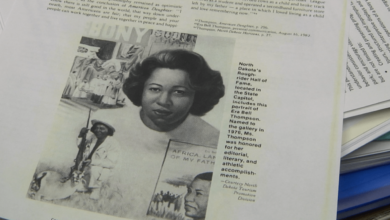Why Popeyes markets its chicken sandwich to African Americans

The chicken craze should, however, have stirred another conversation — about the uneasy relationship among marketing, race and food stereotypes, and the way that these factors have combined to contribute to significant health consequences for African Americans.
While the origins of fried chicken in the United States are blurry, some argue that enslaved people perfected the techniques to make it. We know that the practice originated in the South, and that former slaves later turned their skill at frying chickens into successful entrepreneurship, which led to a long association between fried birds and African American food culture.
Despite these positive connotations, fried chicken has also often been used as a prop in popular culture to degrade black people. D.W. Griffith’s 1915 celebration of the Ku Klux Klan, “The Birth of a Nation,” included a scene featuring Reconstruction-era black legislators feasting on chicken during a formal proceeding. This pejorative stereotype has remained part of our popular culture — on multiple occasions during his career, peers have made tasteless fried chicken jokes about Tiger Woods, for example.
Ironically, given this context, it was the removal of discriminatory barriers by the Civil Rights Act of 1964 that helped forge a relationship between African Americans and fast food.
Before the Civil Rights Act, African Americans were legally shunned from restaurants and rest stops, hotels and hospitals in the South for nearly a century after the end of legal slavery. Even after the law banned racial discrimination in these places, black diners were hesitant to enter spaces that might lead to, at best, bad service or, at worst, violence.
But while they were still vigilant, black consumers were making modest gains in disposable income, which enabled them to finally enjoy the delights of the restaurant world, as their white counterparts long had.
This combination of legal changes and potential new customers provided an opening for fast-food companies. In response to federal programs that offered financial assistance for blacks to enter fast food-franchising and the flight of white business owners from black neighborhoods to the suburbs, fast-food brands discovered that by changing their tone and offering a welcoming experience, they could take advantage of the limited choices available to African American consumers and capture black dollars.
Thus, beginning in the late 1960s, fast-food companies began targeting African Americans with multiethnic marketing campaigns, advertisements crafted by a pathbreaking cohort of tastemakers who enlisted black celebrities, scored R&B and rap tunes and used black idioms to ingratiate themselves to black consumers. From the “Getting Down with Something Good at McDonald’s” advertisements of the 1970s to Muhammad Ali, James Brown and Mahalia Jackson’s brief forays into franchising, the fast-food industry made a concerted effort to court black consumers.
When combined with welcoming atmospheres in their restaurants, as well as convenient locations in black neighborhoods, these advertisements helped cement the bond between black consumers and fast food establishments — including Popeyes.
Popeyes capitalized on the desire of African Americans to feel at home. Founded by New Orleans businessman Al Copeland in 1972, Popeyes Chicken and Biscuits entered a field dominated by Kentucky Fried Chicken. After a few setbacks, Copeland, who was white, realized that he could make Popeyes a success by offering a more spicy take on what Colonel Sanders was offering. He branded the taste as “Cajun,” and the heat in the chicken coupled with side dishes like red beans and rice enamored many black diners.
In taste tests across the fast-food industry, blacks indicated that they used a variety of spices at home that drew upon the diversity of seasonings that represented the indigenous dishes of the African and Caribbean Diasporas to the United States, and they preferred a similar kick when they dined out.
Market research in the late 1970s and early 1980s by the African American research firm ViewPoint Inc. revealed that black customers didn’t buy Copeland’s central marketing claim, which was that Popeyes sold authentic, spicy Cajun cuisine. But black customers remained loyal to the brand anyway, because they felt that Popeyes respected them, and they liked the food.
The flamboyant Copeland himself helped project the sense that Popeyes respected its black customer base. He was a local hero for an annual Christmas holiday display at his suburban New Orleans home. Copeland wrapped his home in thousands of lights, and seasonal music blared onto the streets, infuriating his neighbors with the spectacle and the accompanying traffic.
But the Popeyes founder withstood pressure to conform to neighborhood standards, and in the minds of black Popeyes fans who traveled to his tony neighborhood to see the lights, he stood up for the little people who made him wealthy. In a 1984 market study, one interviewee praised Copeland’s obstinacy in the face of critiques of this winter wonderland display: “You see, the rich people, the people in the neighborhood he live in, they complain about us, the Black people coming into the neighborhood watching these lights.” Copeland, who had grown up in poverty and believed that all people should be able to enjoy Christmas cheer, shrugged these complaints off, impressing African American consumers. As another respondent noted, “I like that he said … that’s his house, he’ll do what he wants with it.”
But while Copeland’s determination to stick up for the little guy might be laudable, the bond between fast-food restaurants — including Popeyes — and African American consumers has had serious consequences.
Centers for Disease Control and Prevention researchers have found that black consumers are more likely than white ones to consume fast food on “any given day.” Researchers have also found ample evidence that African Americans suffer from worse health and shorter life expectancy than white Americans. To name but one example: Over the past 30 years, the National Institutes of Health has noted that African American adults are twice as likely as their white counterparts to develop Type 2 diabetes.
Diet has been shown to be a contributing factor to these maladies. While many advocate for better nutrition education, access to better health care and an end to food deserts, improving these health outcomes will also require understanding the appeal of fast food to African Americans. It’s not just about flavors, or a lack of options. It’s also about the savvy way in which fast-food restaurants have courted African Americans, and offered them an oasis from the cruelty of racism.
The new Popeyes sandwich provides a perfect example: When it debuted in August, observers noted that part of Popeyes’s success in making the chicken sandwich cool was the company’s Twitter account and its reliance on African American vernacular and slang in describing the sandwich and taking jabs at competitors.
The Popeyes account suggested that Wendy’s was “looking thirsty” after tweeting that they indeed sold the best sandwich. In announcing that the sandwich was returning, Popeyes told customers to “come through in your Sunday best” when they visited their local outlet. Popeyes’s use of “y’all” in its tweets, Mardi Gras-themed promotions and African American spokeswoman “Annie” are nods to its roots in Louisiana, as well as a wink to the not-so-subtle associations between African Americans and its signature dish of fried chicken.
But rather than simply lauding this as savvy marketing, we must consider the complicated histories that shaped this campaign — and their ramifications on how African American spend their dollars and the quality of their health.
























































